The Intel 6th Gen Skylake Review: Core i7-6700K and i5-6600K Tested
by Ian Cutress on August 5, 2015 8:00 AM ESTGenerational Tests on the i7-6700K: Legacy, Office and Web Benchmarks
Moving on to the generational tests, and similar to our last Broadwell review I want to dedicate a few pages to specifically looking at how stock speed processors perform as Intel has released each generation. For this each CPU is left at stock, DRAM set to DDR3-1600 (or DDR4-2133 for Skylake in DDR4 mode) and we run the full line of CPU tests at our disposal.
Legacy
Some users will notice that in our benchmark database Bench, we keep data on the CPUs we’ve tested back over a decade and the benchmarks we were running back then. For a few of these benchmarks, such as Cinebench R10, we do actually run these on the new CPUs as well, although for the sake of brevity and relevance we tend not to put this data in the review. Well here are a few of those numbers too.

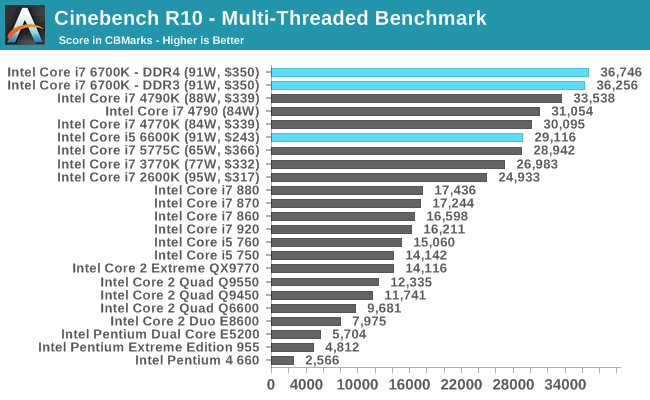


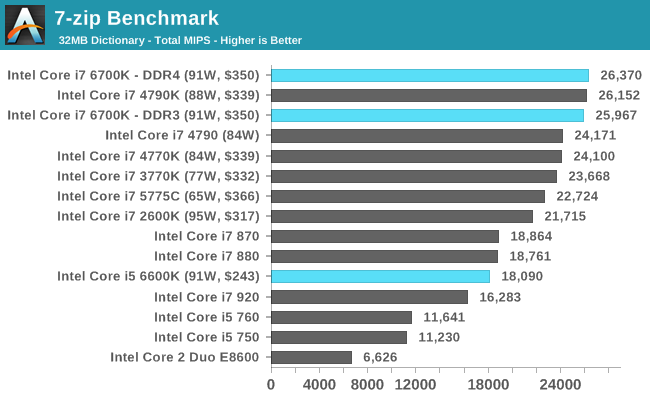
Even with the older tests that might not include any new instruction sets, the Skylake CPUs sit on top of the stack.
Office Performance
The dynamics of CPU Turbo modes, both Intel and AMD, can cause concern during environments with a variable threaded workload. There is also an added issue of the motherboard remaining consistent, depending on how the motherboard manufacturer wants to add in their own boosting technologies over the ones that Intel would prefer they used. In order to remain consistent, we implement an OS-level unique high performance mode on all the CPUs we test which should override any motherboard manufacturer performance mode.
Dolphin Benchmark: link
Many emulators are often bound by single thread CPU performance, and general reports tended to suggest that Haswell provided a significant boost to emulator performance. This benchmark runs a Wii program that raytraces a complex 3D scene inside the Dolphin Wii emulator. Performance on this benchmark is a good proxy of the speed of Dolphin CPU emulation, which is an intensive single core task using most aspects of a CPU. Results are given in minutes, where the Wii itself scores 17.53 minutes.
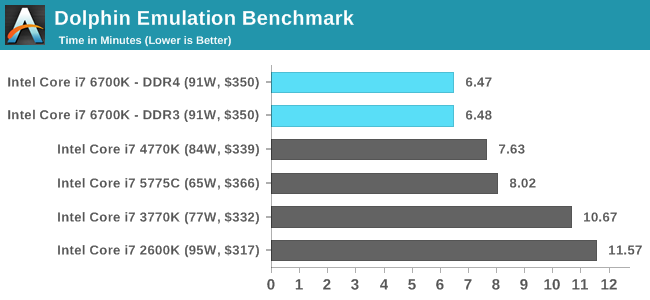
WinRAR 5.0.1: link
Our WinRAR test from 2013 is updated to the latest version of WinRAR at the start of 2014. We compress a set of 2867 files across 320 folders totalling 1.52 GB in size – 95% of these files are small typical website files, and the rest (90% of the size) are small 30 second 720p videos.

3D Particle Movement
3DPM is a self-penned benchmark, taking basic 3D movement algorithms used in Brownian Motion simulations and testing them for speed. High floating point performance, MHz and IPC wins in the single thread version, whereas the multithread version has to handle the threads and loves more cores.
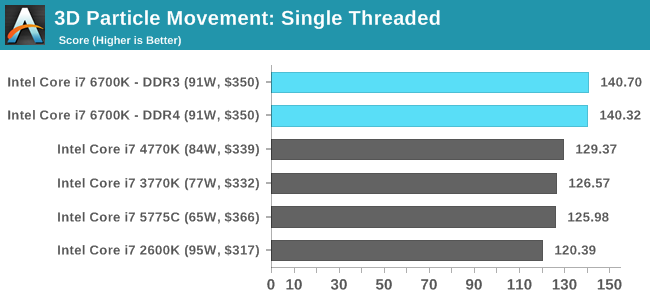
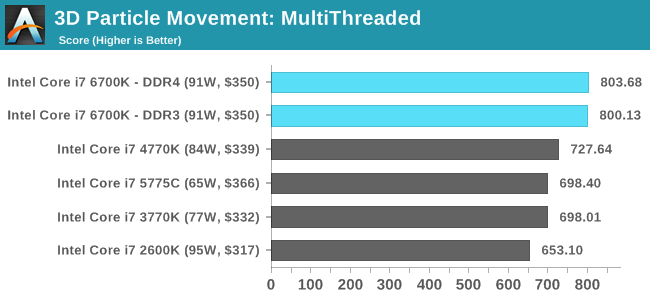
FastStone Image Viewer 4.9
FastStone is the program I use to perform quick or bulk actions on images, such as resizing, adjusting for color and cropping. In our test we take a series of 170 images in various sizes and formats and convert them all into 640x480 .gif files, maintaining the aspect ratio. FastStone does not use multithreading for this test, and results are given in seconds.
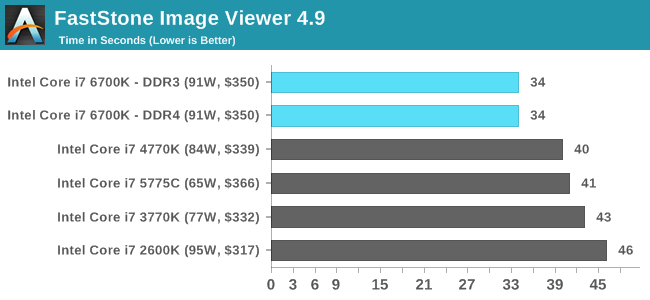
Web Benchmarks
On the lower end processors, general usability is a big factor of experience, especially as we move into the HTML5 era of web browsing. For our web benchmarks, we take four well known tests with Chrome 35 as a consistent browser.
Sunspider 1.0.2
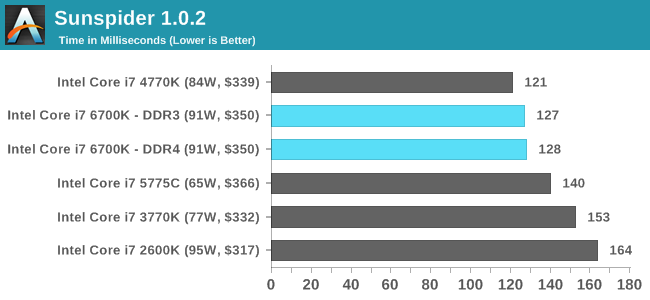
Mozilla Kraken 1.1
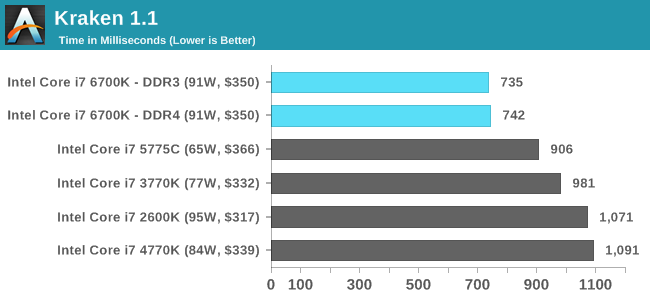
WebXPRT
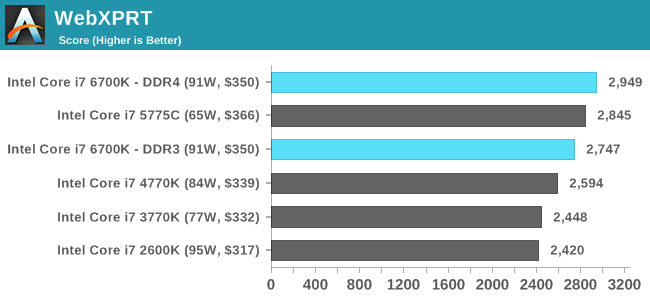
Google Octane v2
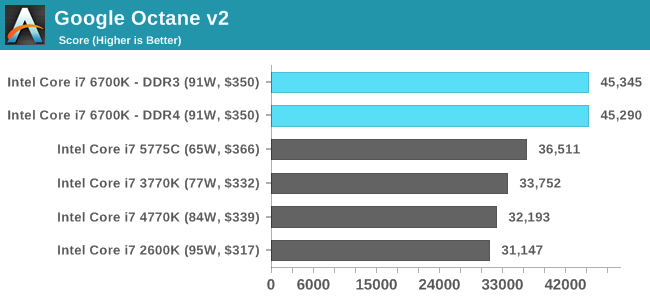










477 Comments
View All Comments
Sunburn74 - Wednesday, August 5, 2015 - link
Still not budging from my 2600K. There is no evidence of real world benefit of an PCIE drive compared to a sata drive. As for the CPUs, the 25% gain IS impressive considering the short time period it has been accomplished in but is just within the threshold of noticeability. Would prefer to wait till maybe 50% gain or when software really starts to take advantage of SSDs.Pneumothorax - Wednesday, August 5, 2015 - link
You're giving Intel too much slack here. Even the much maligned P4 generations had a 50% improvement in raw speed in 2 years. We've waited almost 4 years for only 25%. What's crazy is it cost Intel billions of R&D for it.heffeque - Wednesday, August 5, 2015 - link
25% in 4 yeas... but their iGPU now has more Dx12 Tier 3 support than nVidia and AMD.Nagorak - Wednesday, August 5, 2015 - link
Unfortunately, no serious gamer will ever use it.Bambooz - Wednesday, August 5, 2015 - link
"in my experience all computers are a bit unstable"in other words: you've been buying shitty components :)
kmmatney - Wednesday, August 5, 2015 - link
OK, come on! You bought a "K" cpu - it's meant to overclock - at least bump it up to 4.2-4.3 Ghz - it will run that without any voltage increase. In fact, most motherboards (mine included) seem to overvolt Devil's Canyon cpus, even at stock voltage. In fact, you can probably undervolt it, and overclock it at the same time, as Anandtech did here:You have a guide handed to you for overclocking this cpu:
http://www.anandtech.com/show/8227/devils-canyon-r...
My Z97 PC-Mate motherbard was setting my i5 4690K at 1.2V while at stock, which is higher than it needs - it can run at 4.5Ghz at that setting!
IUU - Saturday, August 8, 2015 - link
I agree with the upgrading part.But not quite with the 25% IPC increase. 25% is awesome.
Two important things:1. It carries the burden of a useless gpu. It could either consume
less energy or the same with more cores. At least then you would use the cpu
where possible for what it's meant to be used.
2. the 25 % increase is the "real" world performance. Unfortunately the "real" world is terribly
slow to take advantages of the improvement Intel introduces with the new instruction sets.
So while it's good to stay down to earth to the "real" world performance, it would be nice to have also a mention of the theoretical improvements of the cpu.
icebox - Wednesday, August 5, 2015 - link
I still don't see the reason to upgrade from a 2600k even though I really urge to upgrade my hardware :) I really don't care about integrated graphics and I'm pretty sure 80% buyers of i7 k parts don't either.There was no reason when ivy brought 5 percent, haswell another 10% and devil 5% more. Now it's a total of 25%. I want more from a total platform change - I moved from 755 to 1155 for a lot more than that. Mainly I want more than 16 PCI lanes, I understand they'll never give us more than 4 cores because xeon and E series.
euler007 - Wednesday, August 5, 2015 - link
Same here, I'm always waiting every generation upgrade my OC'ed 2500k, but I mainly use my home rig for gaming and these benchmarks give me no reason to upgrade. Maybe Skylake-E.moerg - Wednesday, August 5, 2015 - link
so DDR4 offers nothing in gaming?